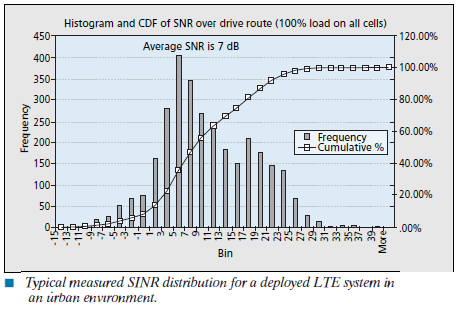Overview:
The challenge with deploying a static N = 1 frequency re-use OFDM system in an interference limited environment is that for a fully loaded deployment, significant regions of coverage will experience negative SINR levels, resulting in gaps in the deployed coverage, irrespective of the inter-cell distance.
Figure given below illustrates a typical SINR distribution for 100 percent loading, as measured in an urban LTE trial deployment with nine cells.

It can be seen that on the order of 15 percent of users will experience negative SINR, with some users experiencing negative SINR levels of –10 to –15 dB. It should be noted that in a fully loaded interference limited cellular deployment the severity of the SINR degradation will be highly dependent on the average path loss exponent. For a cellular deployment with a fixed inter-cell distance, high path loss propagation environments with path loss exponents up to a 5th or 6th order will experience less overall interference than deployments with lower path loss exponents, since potential interfering signals from neighboring cells will be more greatly attenuated in the former case. Even though there will be significant SINR variation depending on the propagation environment, in order to robustly deploy an LTE OFDM system one will have to mitigate the inevitable negative SINR coverage regions that will exist.
The following sections provide an overview of a number of techniques to address the potential SINR coverage holes, including power control, both static fractional frequency reuse (FFR) and adaptive fractional frequency reuse (AFFR), AFFR with tiering, intelligent SINR based scheduling, opportunistic scheduling and access techniques, multiple-input multiple-output (MIMO), and space division multiple access (SDMA) antenna techniques, as well as beamforming.
Note that these techniques can be based on both intra and inter-base station communication approaches.
For complete understanding better to follow this 7 Page document
